
Listen to this post
Herdedwords.com uses affiliate links. This means we receive a commission on the sale of certain items. This is at NO additional cost to you. Visit the policies page to learn more.
The climax in literature is an important part of the story.
The climax of a story occurs at the peak of the rising action. Tension and conflict have been building up until they reach this final peak.
Table of Contents
What Is the Climax of a Story?
The climax of a story is its absolutely biggest moment. Therefore it only makes sense to put it near the end after you’ve had thousands and thousands of words to build up to it.
There’s only one climax, so you need to make it count. It’s the highlight of the novel – everything before builds to it and everything after detracts from it. After the climax, you should only write things that are essential for readers to know. If the reader can envision what happens without you writing it, don’t write it.

Your climax should occur around the 90% mark of your novel, or later. If it happens too early it’s either (1) not the climax or (2) everything after is going to bore readers.
Check out the guide to plot to learn about the other elements.

4 Elements of an Awesome Climax in Literature
You’ve spending thousands of words on rising action – building the tension and conflict to this final peak. Make sure it’s not all wasted by ensuring the climax of your story has these four elements.
#1 – The Climax is the Peak of the Conflict
Your climax should be the highest, strongest, biggest point of the conflict of the novel. If the novel is part of a series, there can be residual conflicts or predicted upcoming conflicts. BUT, whatever the main conflict of this novel was, it should come to a peak.
Let’s use the Hunger Games as an example.
The overall conflict of all three novels is between the districts and the capitol. But that’s not the main conflict of any of the individual novels.
In book 1, the conflict is between Katniss and the Hunger Games. Will she win or will she lose? The climax occurs when it’s only Peeta & Katniss left. Who will win?
In book 2, the conflict is between Katniss and the second Hunger Games she’s forced to participate in. Again, will she win or will she lose?
In book 3, the conflict is between Katniss and President Snow (who represents the capitol). The overall conflict (the districts vs the capitol) plays heavily in the book as well.
In a series, you may have an overall conflict that affects all the books but each book will require it’s own conflict.
#2 – The Climax Should be Inconvenient
Remember – the climax should be the most intense scene of your entire novel. It should not be convenient. It should not feel convenient.
Readers expect characters to be tested to their very limits. If they’re not, your reader is likely to feel let down by the climax (and readers who are unhappy with the climax aren’t going to recommend the book).
Let’s continue with the Hunger Games example.
In book 1, Katniss and Peeta fight epically throughout the book. The end battle sees them fight heroically to win. Yes! They’re the victors. Except, they’re not then the announcement comes. Turns out, there can only be one winner. Will Katniss kill Peeta? Will Peeta kill Katniss? After everything they’ve endured, they’ve reached the final limit.
#3 – No Climactic Clichés
I don’t know about you, but when I’m reading a book I pretty much expect a happy ending. Sometimes I don’t get it (and I’m fine with that) but I’m never surprised when girl/boy fall in love and live happily ever after. I’m never surprised when good triumphs over evil.
However, how girl/boy finally live happily ever after and how good triumphs over evil is important. Readers will roll their eyes if the boy catches the girl just before she boards a plane to confess his love so they can live happily ever after. How many times has that happened in the world of fiction? Too many. It’s a cliché.
Let’s continue with our Hunger Games example.
Everyone expects Katniss to win. The first Hunger Games, the second and ultimately over the Capitol. I can’t imagine anyone being surprised. However, readers enjoy these endings because the climaxes aren’t cliched.
In book 1, Katiness realizes that the Capitol would rather have 2 winners than none, so she suggests they kill themselves rather than each other.
In book 2, Katniss (and her crew) are broken out of the Games but Peeta with heavy losses.
In book 3, Katniss loses her sister (protecting her had been the inciting incident of the first novel). Peeta is never fully cured.
Let’s use Harry Potter as another example. Most everyone is familiar with this story and nobody is surprised that good (Harry) triumphs over evil (Voldemort). But Harry had to die (and come back to life) in order to win. People weren’t known for their ability to come back to life in these novels so this was not a cliché.
#4 – The Climax of a Story is BIG
The climax needs to be momentous. This is not the time for small victories or soft endings.
Be bold. Be daring. Big risk, big reward or big loss. Nothing less than everything is at stake and will be won or lost.
2 Ways to Add Impact to the Climax of a Story
There are two very common ways to add impact to a climax – surprise and/or suspense. These aren’t the only ways, but they’re the most common.
#1 – Surprise
“That came out of nowhere!”
A surprising climax can be difficult to execute well because it can leave readers feeling confused. Even worse is when readers feel robbed of a proper ending.
Surprise endings can easily feel fake, or convenient. It’s like the writer couldn’t think of how to actually end the story so they just threw in a surprise to wrap it all up.
#2 – Suspense
Suspenseful endings are also difficult to execute well because you’ve built readers expectations so high that it’s easy to let them down.
Suspenseful endings can also be very divisive – love it? Hate it? Even if the climax is done extremely well, you’ll have people who will hate it.

Climax Examples
Check out these examples of the climax from bestselling and award-winning novels.
FIFTY SHADES OF GREY
FIFTY SHADES OF GREY, published in 2011, is a romance novel by E. L. James. It’s book 1 in the Fifty Shades trilogy.
FIFTY SHADES OF GREY spent 29 weeks at #1 on the NYT bestseller list. By June 2015 it had sold over 125 million copies worldwide. The movie was released in 2015.
The Climax
Christian beats Ana with a belt resulting in Ana breaking up with him.
#1 – Peaks Conflict
This peaks the conflict in this book – however, it’s the first of a series so we can expect further conflicts to come.
#2 – Inconvenient
Breakups are always inconvenient but especially when one person is more powerful than the other.
Ana wants to escape but is stuck at Christians. She has to remain (temporarily) somewhere she’s very uncomfortable being.
#3 – No Cliches
Romance novels typically end in a more happily-ever-after fashion. This is an anti-cliche. The big breakup happens as the climax.
#4 – Big
The book revolved around the development of their relationship. Breaking up is a big departure from that.
THE GRAVEYARD BOOK
THE GRAVEYARD BOOK, published in 2008, is a children’s fantasy novel by Neil Gaiman.
THE GRAVEYARD BOOK won the 2009 Hugo Award. Disney is planning a movie based on the novel.
The Climax
Bod meets (and fights) Jack.
#1 – Peak of Conflict
Bod is now in a fight for his life – and Scarlett’s. Can he save them?
#2 – Inconvenient
Bod’s desire for revenge means he’s okay with running into Jack and fighting to the death – but he doesn’t want Scarlett to be hurt.
#3 – No Cliches
The bad guy holding the girl hostage is a bit of a cliche.
#4 – Big
It rarely gets bigger than life or death.

Writing Practice
It’s time to practice! The best way to become a better writer is to practice. Try the writing exercises and prompts below and you can master the climax!
Exercise: Analyze More Novels
Every genre will be a little different. Choose some of your favorite novels and some novels in the genre you want to write in (if they’re different). Analyze the climax of each novel.
- What is the climax?
- How does it end the conflict?
- Is it convenient or inconvenient (for the characters)? Why?
- Does it contain any cliches?
- Is it big? Could it be bigger?
Exercise: Analyze LITTLE RED
Answer these questions about the climax of LITTLE RED-CAP.
- What is the climax?
- How does it end the conflict?
- Is it convenient or inconvenient (for the characters)? Why?
- Does it contain any cliches?
- Is it big? Could it be bigger?
Exercise: Adapt LITTLE RED
Now that you understand the climax, it’s time to rewrite it. What if something else had happened?
Your task: Write a new climax of at least 400 words. Make sure it covers the questions from exercise one!
Prompt:
Immortality is like Netflix, only $9.99 a month. But miss a single payment and it’s lights out.
Your task: Write a climax of at least 400 words.
Try Writing by Hand
Sometimes it’s nice to write out prompts and exercises by hand. Give it a try in one of these cheap & fun notebooks!
Think Big and Go Bigger
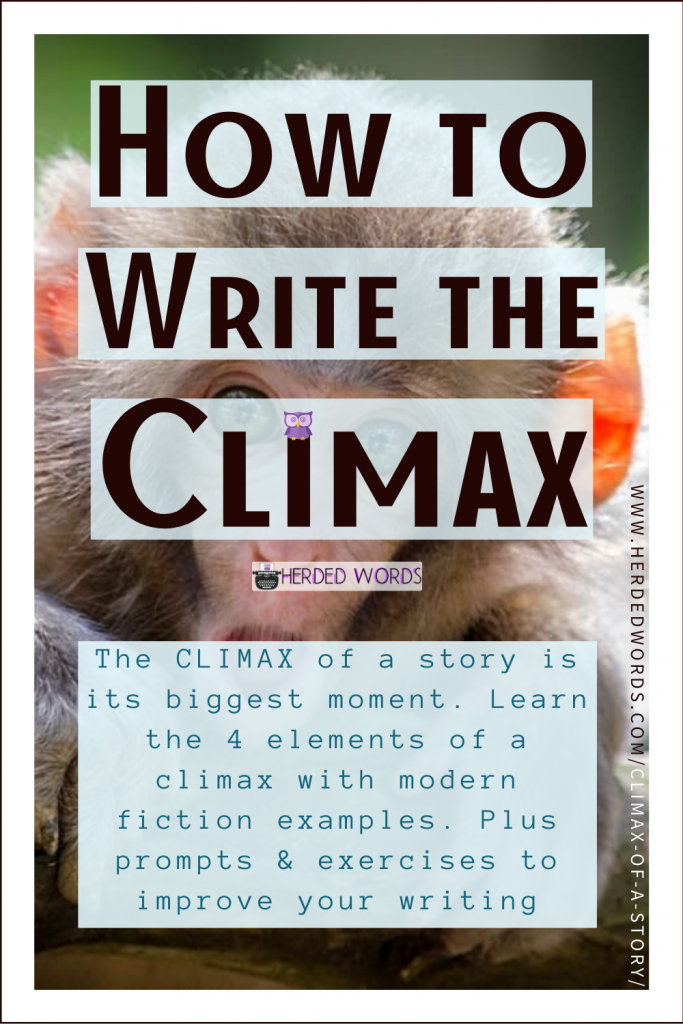
Follow the four elements of an epic climax and you won’t let your readers down.
After your climax, it’s time to wind things down. Check out How to Write Falling Action next.
Like this post? Please PIN IT and follow me on social media. Thanks!
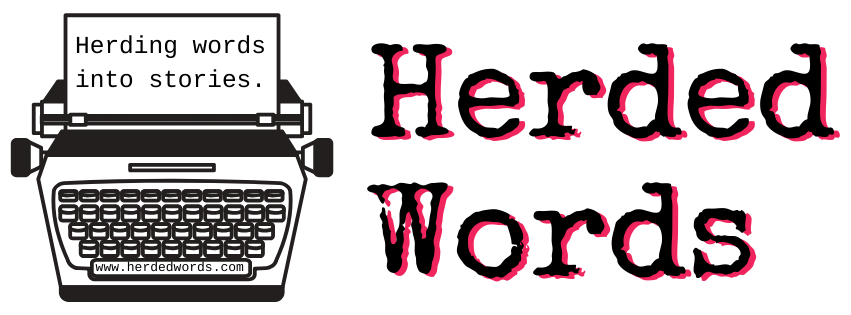
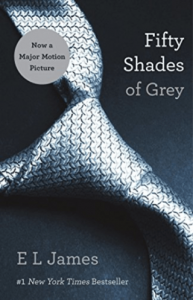
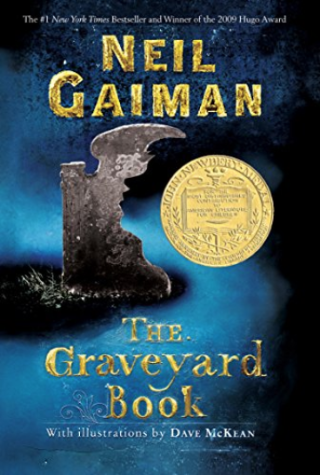

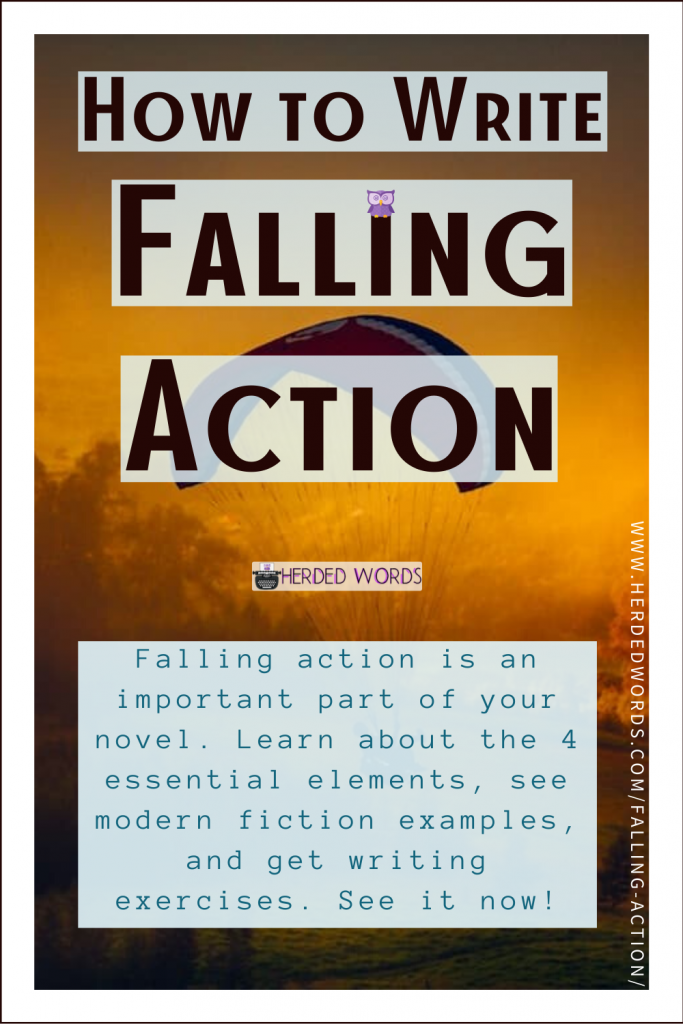






Here s the thing: Many writers skip the build-up. They hurry to the action, to the climax of a story thinking that it s what readers want.